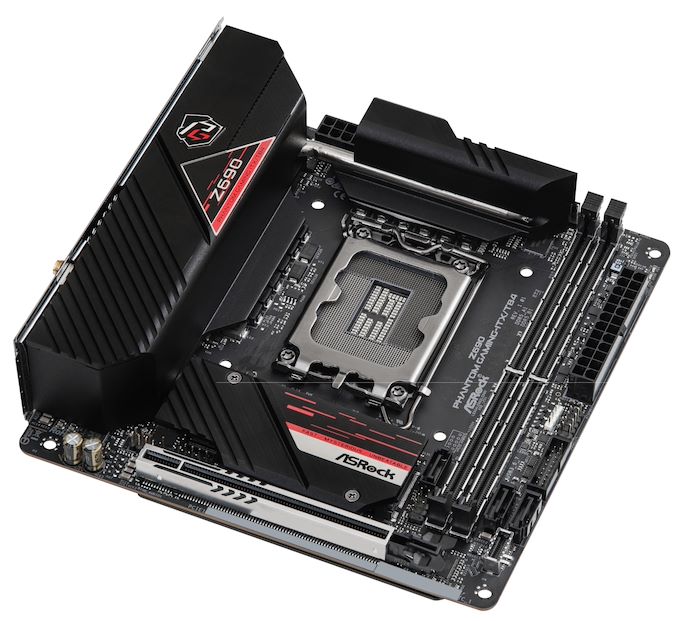The Intel Z690 Motherboard Overview (DDR5): Over 50+ New Models
by Gavin Bonshor on November 9, 2021 9:00 AM ESTASRock Z690 Phantom Gaming-ITX/TB4 (DDR5)
For the launch of Intel's Alder Lake, ASRock has prepared two mini-ITX form factor motherboards for launch, one for the premium market and one for entry-level users. The most premium of the pairing is the ASRock Z690 Phantom Gaming-ITX/TB4 which continues the brand's lineage of providing premium power and features but on the smaller mini-ITX sized platform. The pocket rocket Z690 Phantom Gaming-ITX/TB4 opts for a classy glossy black rear panel cover and heatsink selection, with elements of red around the board and within the ASRock and PG gaming logo too. ASRock is also advertising an 11-phase power delivery with smart power stages, with a single 8-pin 12 V ATX CPU power input delivering power to the processor.
As this is a mini-ITX sized motherboard, it includes just one full-length PCIe slot which is operating at PCIe 5.0 x16. As a consequence of its size, it's only able to fit two PCIe 4.0 x4 M.2 slots on it and opts for just three SATA ports, which are still capable of supporting Intel RAID 0, 1, 5, and 10 arrays. On the right-hand side of the board is a pair of memory slots that are capable of supporting DDR5-6400 out of the box, with a combined capacity of up to 64 GB.
One of the board's most prominent features is that it has one Thunderbolt 4 Type-C port, with additional support from four USB 3.2 G2 Type-A, and one USB 3.2 G1 Type-A port. Integrated audio consists of five 3.5 mm audio jacks with one S/PDIF optical output powered by a Realtek ALC1220 HD audio codec, with a Killer E3100G 2.5 GbE controller and Killer AX1675 Wi-Fi 6E CNVi providing the boards networking support. Finishing off the rear panel is one HDMI 2.1 and one DisplayPort 1.4 video output, with a clear CMOS button and BIOS Flashback button.












126 Comments
View All Comments
Duwelon - Tuesday, November 9, 2021 - link
Asus' prices are completely bananas. If I build a new rig with Z690 it'll probably be my first non-Asus build in a very long time.Sivar - Tuesday, November 9, 2021 - link
That caught my eye, too. I bought an Asus Hero-branded board for my current system last year at approximately $200 USD.I suspect Asus is shifting their marketspeak because the word "Maximus" (used for the z690 board but not mine) usually applies to their most expensive boards.
blppt - Tuesday, November 9, 2021 - link
This. $2000 for a consumer grade motherboard? WTF are they smoking?Also, I'm pretty sure ASUS will be releasing some TUF Z690s at some point, probably at a lower price point than the primes. My experience with the TUF series has been very positive for the price.
DigitalFreak - Tuesday, November 9, 2021 - link
They know they're not going to sell many of those. Those boards are either for LN2 e-peen competitions or people with more money than sense.Wrs - Wednesday, November 10, 2021 - link
TUF is historically just a bit more expensive than Prime. They already have a TUF DDR4 version - ordered the Wifi one for $290 the other day. If worried about price DDR5 is the first mistake.blppt - Wednesday, November 10, 2021 - link
The X570 TUF was cheaper than the X570 Prime when I went shopping for an AMD board.COtech - Tuesday, November 9, 2021 - link
Subtitle - "Intel Z690 Chipset: Like Z590, But Now With Native PCIe 4.0"I think "But Now With Native PCIe 5.0" is intended.
gavbon - Thursday, November 18, 2021 - link
The Z690 chipset doesn't have PCIe 5.0, this comes from the CPU. The Z690 chipset does, however, now include PCIe 4.0 lanes, whereas Z590 did not.Someguyperson - Tuesday, November 9, 2021 - link
I don't get the "DP IN" ports on the ASUS ProArt Z690 Creator WIFI. I see the author just wrote what was on the ASUS website, but that doesn't really explain anything. Are they passthrough to the Thunderbolt out ports? Is there a capture card built into this motherboard? I'm very confused by the labeling here.uwsalt - Tuesday, November 9, 2021 - link
Those are passthrough to the Thunderbolt port. Add-in Thunderbolt cards work the same way. You slot in your discrete GPU, send the output from both DP ports to the Thunderbolt controller, and then use Thunderbolt to output to a Thunderbolt monitor or hub.